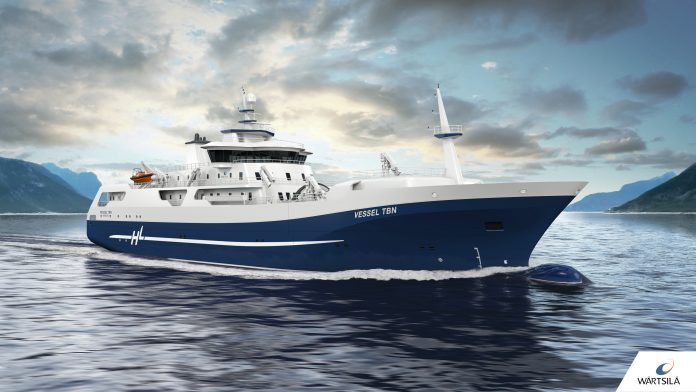Notable environmental gains are made possible by a Wartsila hybrid propulsion system supported by batteries, which results in very low emission levels.
The Wartsila technology group has been contracted to deliver the ship design for a new processing and transportation vessel to be built at the Balenciaga shipyard in Spain on behalf of Hav Line AS of Norway. In addition to the design, Wartsila will also supply an integrated system comprising a 10-cylinder Wartsila 31 main engine, auxiliary engines, propulsion machinery, the propulsion remote control system, and the electrical & automation system. The delivery of the Wartsila system will be during autumn 2017 and the vessel is scheduled for delivery in summer 2018. The order was recorded in Wartsila’s order book in the fourth quarter of 2016.
This will be the world’s first processing and transportation vessel for the fish farming industry to utilise this solution. By absorbing most of the engine’s load fluctuations and vessel load variations through batteries, the engine can be operated close to its optimum design point, thereby providing the highest level of efficiency, which in turn minimises exhaust emissions.
The Wartsila design is tailor made to the customer’s specifications. During the development phase of the project, the Finnish company acted as the owner’s consultant to ensure an environmentally sound and functionally effective solution. The vessel’s hybrid propulsion machinery has the PTI/PTO (power take-in/ power take-off) powered by batteries, and is combined with the very fuel efficient Wartsila 31 main engine. The environmentally sustainable hybrid battery configuration is new for this type of vessel.
“The fish farming industry, like other marine industry sectors, is seeking better ship designs and greater efficiencies that reduce overall operating costs and lessen the environmental impact. Wärtsilä is proud to have been selected for this project that introduces the world’s first hybrid propulsion system for this kind of vessel,” says Riku-Pekka Hagg, Vice President, Wartsila Ship Design.
“We very much appreciate Wartsila’s support in designing a vessel that meets our operational and environmental requirements,” says Jon Hinder, Chairman of the board, Hav Line Gruppen AS.
The integrated solution includes the initial, basic, and detailed ship design, a 10-cylinder Wartsila 31 main engine, a Wartsila 2-speed gearbox, a Wartsila controllable pitch propeller (CPP) including the HP propeller nozzle, stern tube seals and bearings, the Wartsila ProTouch propulsion remote control system, two 9-cylinder Wärtsilä 20 auxiliary engines, and the electrical & automation system including a hybrid battery PTI/PTO package.
The Wartsila 2-speed gearbox enables lower propeller speeds and optimised propulsion efficiency during transit, while still using the main engine to power the shaft alternator. This results in lower fuel costs, both for propulsion and production of electrical power. The custom designed CPP propeller is of the company’s successful G-hub configuration and is combined with the HP nozzle. This provides maximum reliability and efficiency and is a popular choice for vessels with this operational profile.
Following its introduction in 2015, the Wartsila 31 was recognized as the world’s most efficient 4-stroke diesel engine by Guinness World Records. The main features of the engine are its exceptionally low fuel consumption and minimal maintenance requirements. For this engine the main service is required only after 32,000 running hours, whereas alternative standard marine engines require maintenance after 24,000 running hours. This level of propulsion efficiency, combined with the Wartsila design, will produce notable operational cost savings.

